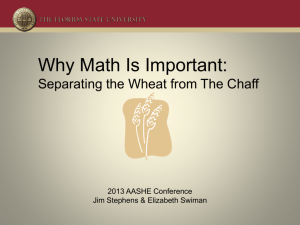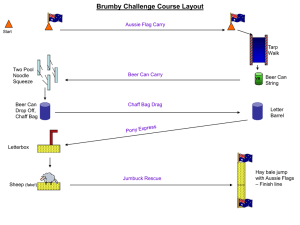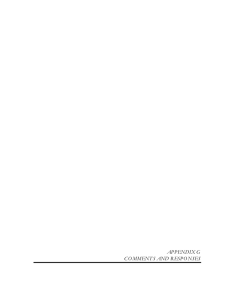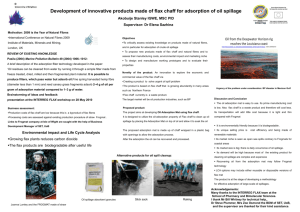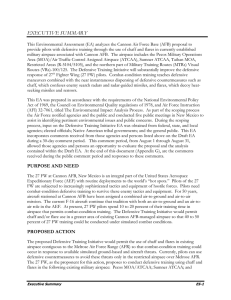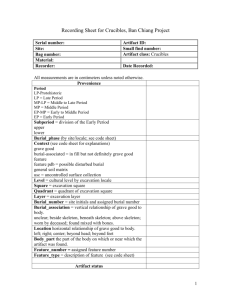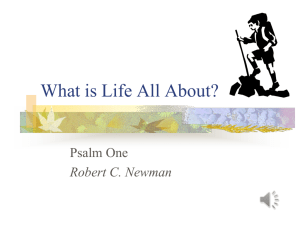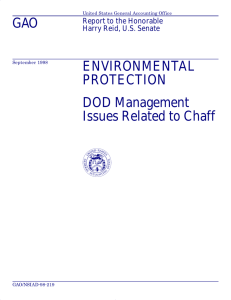APPENDIX A CHARACTERISTICS OF CHAFF
advertisement
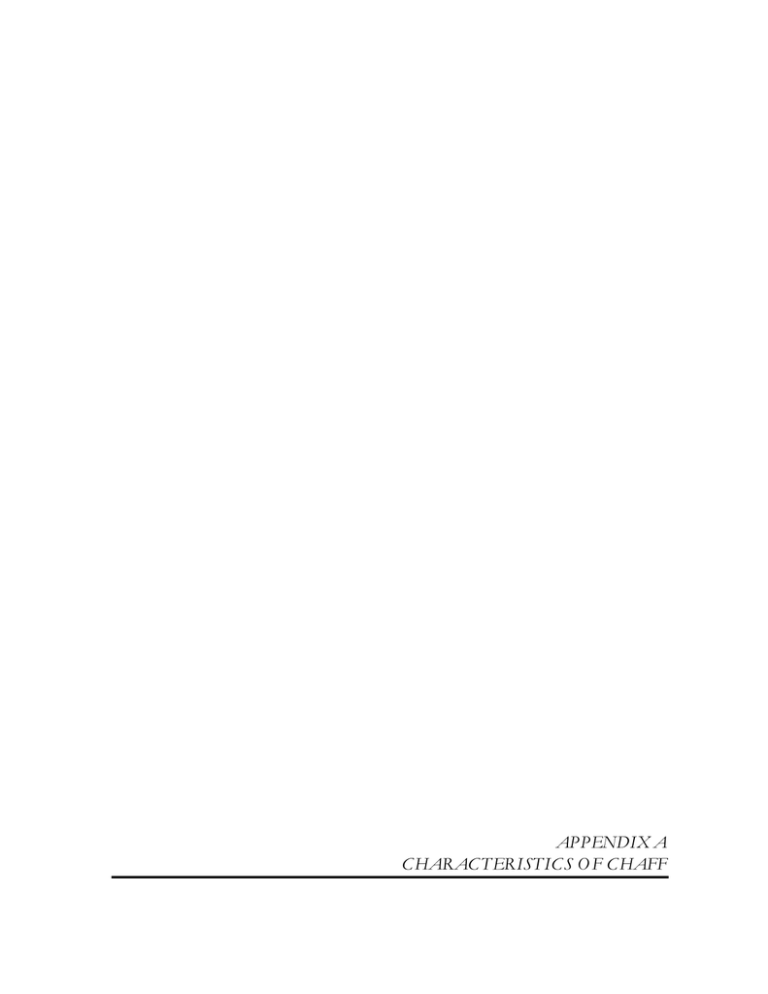
APPENDIX A CHARACTERISTICS OF CHAFF CHARACTERISTICS OF CHAFF The proposed action would employ RR-188 training chaff. When released from an aircraft, chaff initially forms a sphere, then disperses in the air. The chaff effectively reflects radar signals in various bands (depending on the length of the chaff fibers) and forms a very large image or electronic “cloud” of reflected signals on a radar screen. The aircraft is obscured from radar detection by the cloud, which allows the aircraft to safely maneuver or to leave an area. Since chaff can obstruct radar, its use is coordinated with the Federal Aviation Administration (FAA). RR-188 training chaff has D and E band dipoles removed to avoid interference with FAA radar. Chaff Composition The RR-188 chaff used during training consists of extremely small strands (or dipoles) of an aluminum-coated crystalline silica core. The chaff components (silica, aluminum, and stearic acid) are generally prevalent in the environment. Silica (silicon dioxide) belongs to the most common mineral group, silicate minerals. Silica is inert in the environment and does not present an environmental concern with respect to soil chemistry. Aluminum is the third most abundant element in the earth’s crust, forming some of the most common minerals, such as feldspars, micas, and clays. Natural soil concentrations of aluminum ranging from 10,000 to 300,000 parts per million have been documented (Lindsay 1979). These levels vary depending on numerous environmental factors, including climate, parent rock materials from which the soils were formed, vegetation, and soil moisture alkalinity/acidity. The solubility of aluminum is greater in acidic and highly alkaline soils than in neutral pH conditions. Aluminum eventually oxidizes to Al2O3 (aluminum oxide) over time, depending on its size and form and the environmental conditions. Stearic acid is an animal fat that degrades when exposed to light and air. The chaff fibers have an anti-clumping agent (Neofat – 90 percent stearic acid and 10 percent palmitic acid) to assist with rapid dispersal of the fibers during deployment (Air Force 1997). Chaff is made as small and light as possible so that it will remain in the air long enough to confuse enemy radar. The chaff fibers are approximately the thickness of a human hair (i.e., generally 25.4 microns in diameter), and range in length from 0.3 to over 1 inch. The weight of chaff material in the RR188 cartridge is 95 grams (Air Force 1997). A single bundle of chaff consists of the filaments in an 8-inch long rectangular tube or cartridge, a plastic piston, a cushioned spacer and a 1-inch by 1-inch plastic end cap that falls to the ground when chaff is dispensed. The spacer is a spongy material (felt) designed to absorb the force of release. Figure 1 illustrates the components of a chaff cartridge. Table 1 lists the components of the silica core and the aluminum coating. Table 2 presents the characteristics of RR-188 chaff. Chaff Ejection Chaff is ejected from aircraft pyrotechnically using a BBU-35/B impulse cartridge. Pyrotechnic ejection uses hot gases generated by an explosive impulse charge. The gases push the small piston down the chaff-filled tube. A small plastic end cap is ejected, followed by the chaff fibers. The plastic tube remains within the aircraft. Debris from the ejection consists of two small, square pieces of plastic 1/8-inch thick (i.e., the piston and the end cap) and the felt spacer. Table 3 lists the characteristics of BBU-35/B impulse cartridges used to pyrotechnically eject chaff. A-1 Figure 1. RR-188/AL Chaff Cartridge (Source: Air Force 1999) Table 1. Components of RR-188 Chaff Element Chemical Symbol Percent (by weight) Silica Core Silicon dioxide Alumina Calcium Oxide and Magnesium Oxide Boron Oxide Sodium Oxide and Potassium Oxide Iron Oxide SiO2 52-56 Al2O3 12-16 CaO and MgO 16-25 B2O3 8-13 Na2O and K2O 1-4 Fe2O3 1 or less Aluminum Coating (Typically Alloy 1145) Aluminum Silicon and Iron 99.45 minimum Si and Fe 0.55 maximum Copper Cu 0.05 maximum Manganese Mn 0.05 maximum Magnesium Mg 0.05 maximum Zinc Zn 0.05 maximum Vanadium V 0.05 maximum Titanium Ti 0.03 maximum Others Source: Air Force 1997 A-2 Al 0.03 maximum Table 2. Characteristics of RR-188 Chaff Attribute Aircraft Composition RR-188 A-10, F-15, F-16 Aluminum coated glass Ejection Mode Pyrotechnic Configuration Rectangular tube cartridge Size 8x1x1 inches (8 cubic inches) Number. of Dipoles 5.46 million Dipole Size (crosssection) 1 mil (diameter) Impulse Cartridge BBU-35/B Other Comments Cartridge stays in aircraft; less interference with FAA radar (no D and E bands) Source: Air Force 1997 Table 3. BBU-35/B Impulse Charges Used to Eject Chaff Component Overall Size Overall Volume Total Explosive Volume Bridgewire Initiation Charge Booster Charge Main Charge BBU-35/B 0.625 inches x 0.530 inches 0.163 inches3 0.034 inches3 Trophet A 0.0025 inches x 0.15 inches 0.008 cubic inches 130 mg 7,650 psi boron 20% potassium perchlorate 80% * 0.008 cubic inches 105 mg 7030 psi boron 18% potassium nitrate 82% 0.017 cubic inches 250 mg Loose fill RDX ** pellets 38.2% potassium perchlorate 30.5% boron 3.9% potassium nitrate 15.3% super floss 4.6% Viton A 7.6% A-3 Source: Air Force 1997 Upon release from an aircraft, chaff forms a cloud approximately 30 meters in diameter in less than one second under normal conditions. Quality standards for chaff cartridges require that they demonstrate ejection of 98 percent of the chaff in undamaged condition, with a reliability of 95 percent at a 95 percent confidence level. They must also be able to withstand a variety of environmental conditions that might be encountered during storage, shipment, and operation. Table 4 lists performance requirements for chaff. Table 4. Performance Requirements for Chaff Condition Performance Requirement High Temperature Up to +165 degrees Fahrenheit (oF) Low Temperature Down to –65 oF Temperature Shock Shock from –70 oF to +165 oF Temperature Altitude Combined temperature altitude conditions up to 70,000 feet Humidity Up to 95 percent relative humidity Sand and Dust Sand and dust encountered in desert regions subject to high sand dust conditions and blowing sand and dust particles Accelerations/Axis G-Level Time (minute) Transverse-Left (X) 9.0 1 Transverse-Right (-X) 3.0 1 Transverse (Z) 4.5 1 Transverse (-Z) 13.5 1 Lateral-Aft (-Y) 6.0 1 Lateral-Forward (Y) 6.0 1 Shock (Transmit) Shock encountered during aircraft flight Vibration Vibration encountered during aircraft flight Free Fall Drop Shock encountered during unpackaged item drop Vibration (Repetitive) Vibration encountered during rough handling of packaged item Three Foot Drop Shock encountered during rough handling of packaged item Note: Cartridge must be capable of total ejection of chaff from the cartridge liner under these conditions. Source: Air Force 1997 Policies and Regulations on Chaff Use Current Air Force policy on use of chaff and flares was established by the Airspace Subgroup of Headquarter (HQ) Air Force Flight Standards Agency (AFFSA) in 1993 (Memorandum from John R. Williams, 28 June 1993). It requires units to obtain frequency clearance from the Air Force Frequency Management Center and the FAA prior to using chaff to ensure that training with chaff is conducted on a non-interference basis. This ensures electromagnetic compatibility between the FAA, the Federal Communications Commission (FCC), and Department of Defense (DoD) agencies. The Air Force does not place any restrictions on the use of chaff provided those conditions are met (Air Force 1997). A-4 AFI 13-201, U.S. Air Force Airspace Management, July 1994. This guidance establishes practices to decrease disturbance from flight operations that might cause adverse public reaction. It emphasizes the Air Force’s responsibility to ensure that the public is protected to the maximum extent practicable from hazards and effects associated with flight operations. AFI 11-214 Aircrew and Weapons Director and Terminal Attack Controller Procedures for Air Operations, July 1994. This instruction delineates procedures for chaff and flare use. It prohibits use unless in an approved area. References Air Force. 1997. Environmental Effects of Self-Protection Chaff and Flares. Prepared for Headquarters Air Combat Command, Langley Air Force Base, Virginia. _____. 1999. Description of the Proposed Action and Alternatives (DOPAA) for the Expansion of the Use of Self-Protection Chaff and Flares at the Utah Test and Training Range, Hill Air Force Base, Utah. Prepared for Headquarters Air Force Reserve Command Environmental Division, Robins AFB, Georgia. _____. 2000. Additional Information and Analysis of Proposed Use of Defensive Chaff in the Airspace Known as the Carrabelle and Compass Lake Work Areas (Military Operations Areas). Prepared for the U.S. Air Force Air Education and Training Command (AETC). Tyndall Air Force Base, Florida. A-5

